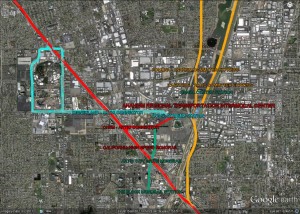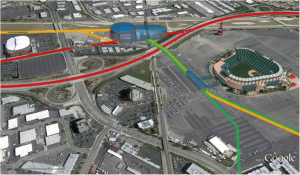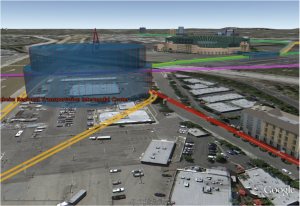 Originally designed for the Orange County Transportation Authority as a common station complex providing linkages and transfer capabilities between existing Amtrak and Metrolink rail services, the proposed San Francisco-Los Angeles-San Diego high-speed rail service, local bus lines and a light rail or monorail serving the Anaheim Convention Center and Disneyland, the Anaheim Regional Transportation Intermodal Center station complex has been reevaluated and significantly redesigned in light of the diminishing prospects of California’s high-speed rail service ever reaching Anaheim or Orange County. Dependent on up to 90% of its projected passenger volume and revenue from high-speed rail, the Anaheim station complex would not be a viable project under any scenario that did not include an ARTIC high-speed rail station.
Originally designed for the Orange County Transportation Authority as a common station complex providing linkages and transfer capabilities between existing Amtrak and Metrolink rail services, the proposed San Francisco-Los Angeles-San Diego high-speed rail service, local bus lines and a light rail or monorail serving the Anaheim Convention Center and Disneyland, the Anaheim Regional Transportation Intermodal Center station complex has been reevaluated and significantly redesigned in light of the diminishing prospects of California’s high-speed rail service ever reaching Anaheim or Orange County. Dependent on up to 90% of its projected passenger volume and revenue from high-speed rail, the Anaheim station complex would not be a viable project under any scenario that did not include an ARTIC high-speed rail station.
With the grossly underfunded California High-Speed Rail Authority floundering in the state’s agricultural San Joaquin Valley, federal high-speed rail funding under increasing congressional criticism and cost estimates to complete a partial system escalating to between100 and 200 billion dollars, the California High-Speed Rail Authority is likely to be forced to abandon the project by 2012. The imminent curtailment of high-speed rail in California and Orange County would remove the greatest source of patronage and revenue from the ARTIC station complex, thus contributing to financially unsustainable local and regional transportation systems, and obviating the need for ARTIC development altogether.
The Anaheim Regional Transportation Intermodal Center (ARTIC), currently in the design stages of the Orange County Transportation Authority’s regional development program, would serve as a multi-modal, multi-service nexus point in a single Southern California monorail station complex. American Monorail’s proposed ARTIC Station would serve and link the Pomona-Anaheim, Riverside-Anaheim, Los Angeles- Anaheim and Anaheim-San Diego Commuter Express monorails with the proposed Anaheim-Las Vegas and San Diego-San Francisco High-Speed Monorail systems, the proposed Disneyland Monorail, existing Metrolink and Amtrak rail, as well as, local and regional bus services in a single station complex located near Angels baseball stadium in the City of Anaheim.


American Monorail’s proposal to develop an all-monorail ARTIC station complex would serve as an Orange County nexus of local, commuter and high-speed monorail routes and services. With local connections and stations at Angels Stadium, Disneyland, Anaheim Convention Center and The Block at Orange shopping and entertainment center, ARTIC monorail station would link commuter express monorail services from Riverside, Corona, San Diego and Los Angeles, as well as, high-speed monorails from Las Vegas, Los Angeles and San Diego with local monorail, bus and Amtrak/Metrolink services in a seamless transitional facility. In the event that high-speed monorail services are not developed or connected to the ARTIC monorail complex, Riverside-Corona, Los Angeles and San Diego express commuter and local venue monorail systems could potentially serve hundreds of thousands of passengers per day through the ARTIC monorail station complex. Fare income generated by such volume of ridership could be expected to provide revenue sufficient to support all maintenance and operational expenses, as well as, the servicing of construction and system development debt; while removing thousands of vehicles, and tens of thousands of daily vehicle trips from Southern California freeways, highways and urban streets.




